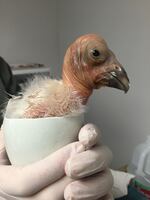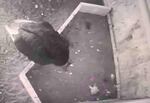The 1973 Endangered Species Act was designed to protect and recover imperiled species across the country. One of the original animals included in the act was the California condor, a bird that today is still classified as critically endangered.
According to U.S. Fish and Wildlife records, there were only 22 condors left in the world by 1982. Five years later, in an attempt to save the species from extinction, all remaining wild condors were placed into captive breeding programs.
One of those programs is in Oregon, where recovery efforts by the Oregon Zoo take place at the 52-acre Jonsson Center for Wildlife Conservation. In 2003, the first six breeding pairs were brought to the center and currently the program has 40 birds, 14 of which are breeding pairs. Since the program started, over 50 condors raised by the Oregon Zoo have been released into the wild.
This month, the Oregon Zoo welcomed the first condor chick of 2020.

A 24-hour-old California condor chick is put back in a shell after hatching.
Kelli Walker / Courtesy of the Oregon Zoo
“[The] chick comes, out and all its little downy feathers are wet. Kind of looks slippery,” said Kelli Walker, the zoo’s lead condor keeper. “When they dry off, they actually are a white ball of fluff with a bald head and giant eyeballs.”
As a teen, Walker started working with animals at the Audubon Wildlife Care Center in Portland. Having always had an interest in conservation, she joked that when the opportunity to work with the condor project came along.
“I raised my hand and jumped up and down and said, ‘Pick me!’" Walker said.
The Oregon Zoo got its first condor egg of the year at the end of January, and that’s a big deal because California condors are slow to reproduce. They lay one egg every year or two.
In fact, Walker said another egg was just laid on Monday. She took us through a step-by-step process of what happens next:
"[After the egg is laid], we try to keep them under the pair for some natural incubation. It really helps the chick hatch out later,” she said. “So, we try to keep that egg in the nest room for about 12 to 14 days. ... The way our cameras are, they’re a little bit hard to see because the parents will sit really tight on him for at least the first 24 hours. It's always kind of a guessing game. Like, ‘OK, the parents moving around, so the chick must be moving.’”
Typically, newly hatched chicks are raised by pairs of condors, with the male and female condors both tending to the baby bird. But this chick is being raised by a single mother.
“So, this mom has the entire responsibility,” Walker says.

A newly hatched California condor chick (circled in purple) is seen with its mother.
Kelli Walker / Courtesy of the Oregon Zoo
For the next eight months, the chick will stay close to its parent's side. “It will fledge out of the pan, which means it will join the mom in the pen,” Walker said. “Mom will teach it how to eat, how to break into carcasses.”
But these condor chicks still have some additional life skills to learn before they are released into the wild. That’s because California condors learn a lot of cues visually and through a social group. So, after eight months, the birds go into a pre-release pen where they are housed with a mentor bird.
“His name is Antop, and he keeps all those chicks in line,” Walker said. “It can be like Lord of the Flies in there if there's no mentor.”
The large pre-release pen is situated at the edge of the Oregon Zoo, next to a stream. In the pen is a mock power poll specifically designed for aversion therapy. “If they land on the power poll, it delivers a small shock, which is uncomfortable to the birds.” Walker says that it teaches them not to land on power poles. “The program has been very, very successful.”
After about a year and a half in the pre-release pen, the birds will be gathered up and transported to a site to be released in the wild.
“It’s a pretty amazing program,” Walker said. “The wild birds are pairing up, and they’re raising wild chicks, which is awesome.”
Recovery programs like the Oregon Zoo's have helped to increase the California condor population to more than 517 birds, most of which are now in the wild.